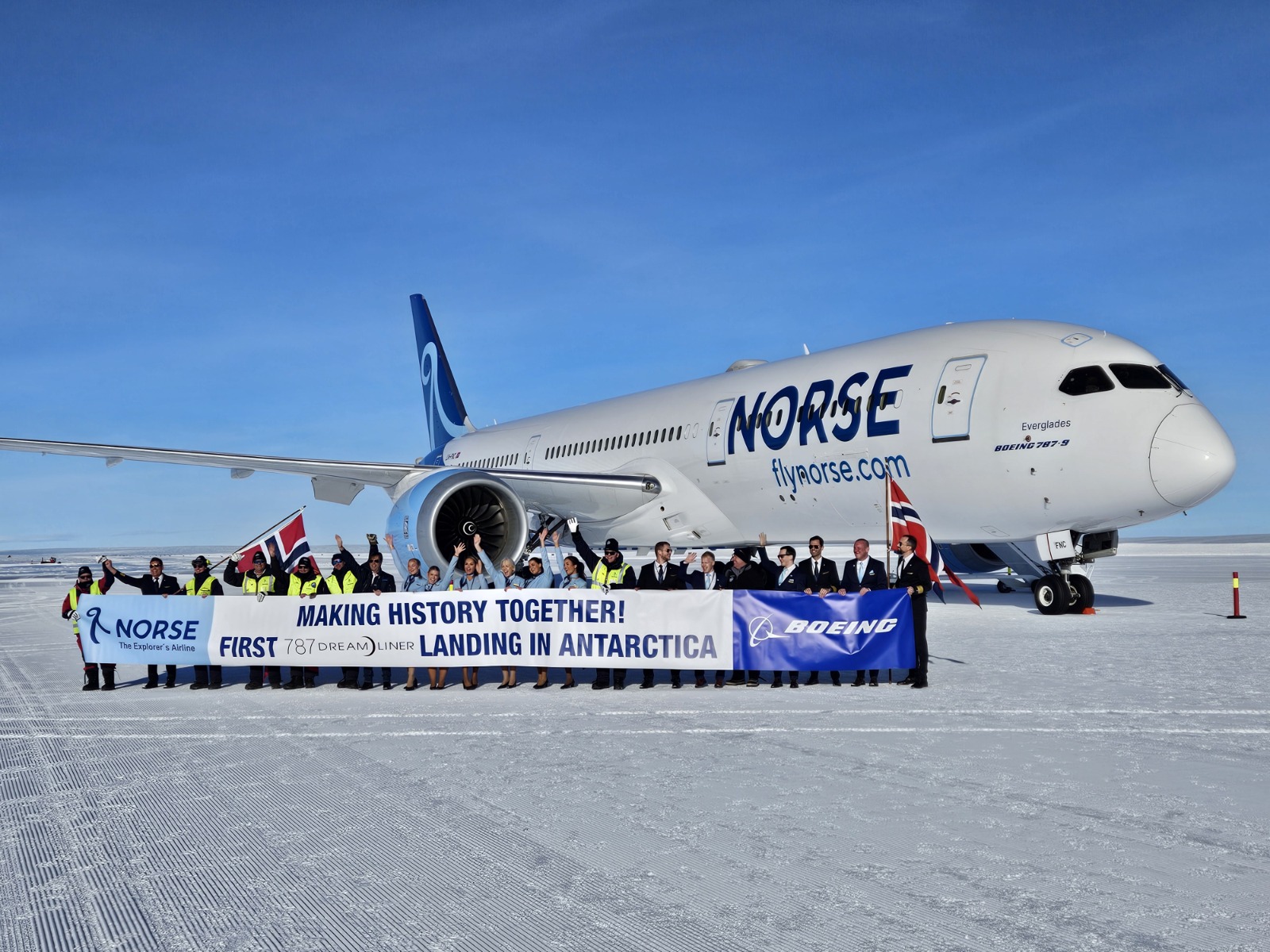In a historic achievement, Norse Atlantic Airways has etched its name in aviation history by becoming the first airline to land a Boeing 787 Dreamliner in Antarctica.
Meanwhile, in November 2021, an Airbus A340 plane landed in Antarctica for the first time. Hi Fly, a boutique aviation company, was behind the flight. It was for the first time in history that an Airbus A340 landed in Antarctica.
On November 15, 2023, the Dreamliner with registration LN-FNC, operated by Norse Atlantic Airways, successfully concluded its extensive journey from Oslo to Troll Airfield (QAT) in Queen Maud Land, Antarctica, with a layover in Cape Town (CPT), South Africa.
This flight transported 45 individuals, comprising researchers from the Norwegian Polar Institute, along with 12 tons of essential equipment destined for various research stations across the frozen continent.
The touchdown at Troll Airfield marked a key milestone as the first-ever landing of a Boeing 787 in Antarctica. This achievement also signifies that the Boeing 787 has successfully operated flights to every continent globally.
The Dreamliner’s landing and departure at Troll Airfield were captured on video and subsequently shared on the Norwegian airline’s YouTube channel.
Equipped with a 3,000-meter blue ice runway crafted from compacted ice and snow, Troll Airfield is a vital gateway from Antarctica to the world, functioning as a base for the Dronning Maud Land Air Network Project (DROMLAN).
In a collective effort, 11 nations—Norway, Belgium, Finland, Germany, India, Japan, the Netherlands, Russia, South Africa, Sweden, and the United Kingdom—jointly contribute logistical resources as part of the DROMLAN.

The airfield operates as a central distribution point for smaller bases, served by ski-fitted Basler BT-67 aircraft, a heavily modified version of the iconic DC-3.
Despite Queen Maud Land’s geographical distance from Norway, the Scandinavian country claims sovereignty over this region, extending its territorial presence to include Bouvet Island, an uninhabited islet approximately halfway between South Africa and Antarctica.
In a statement, Norse Atlantic Airways CEO Bjørn Tore Larsen said, “It is a great honor and excitement on behalf of the entire team Norse that we have achieved together a momentous moment of landing the first 787 Dreamliner.”
“In the spirit of exploration, we are proud to have a hand in this important and unique mission. It is a true testament to our highly trained and skilled pilots and crew and our state-of-the-art Boeing aircraft,” he added.
Optimal Qualities Of The 787 Dreamliner For Antarctic Missions
The Dreamliner’s generous cargo capacity, as highlighted by Daniel Carey of Aircontact, the broker facilitating the flight, positioned it as the optimal aircraft for the journey to Antarctica.
Leveraging a modern aircraft such as the 787 Dreamliner facilitates the conveyance of more excellent passenger and cargo volumes, thereby reducing the environmental impact of flight operations to and from Antarctica.
This strategy lessens the need for frequent flights to support remote research stations, fostering both efficiency and environmental sustainability.
Paul Erlandsson, a field service representative at Boeing, further highlighted the significance of the Dreamliner’s fuel efficiency, noting that the aircraft completed the round-trip journey between Antarctica and Cape Town without requiring refueling.
Similarly, the Director of the Norwegian Polar Institute, Camilla Brekke, said that employing larger aircraft represents a more sustainable approach to accessing the notably delicate continent.
“The most crucial aspect is the environmental gain we can achieve by using large and modern aircraft… [which] can help reduce overall emissions and the environmental footprint in Antarctica,” she said.
“Landing such a large aircraft opens up entirely new possibilities for logistics at Troll, which will also contribute to strengthening Norwegian research in Antarctica,” Brekke added.
Nevertheless, the operation of large aircraft in Antarctica is contingent upon the availability of a suitable runway. The meticulous planning and utilization of flexible technology are imperative for the development and upkeep of an ice runway in the challenging environment of Antarctica.
Even after the completion of construction, the runway continues to grapple with persistent challenges stemming from the ever-unpredictable weather conditions prevalent in Antarctica.
Yet, flights to and from the continent are fraught with uncertainties, compelling pilots to navigate through demanding skies under optimal circumstances—clarity of visibility, gentle winds, and the absence of precipitation.
As the ice begins to melt in the relatively warmer months of December and January, the runway becomes slippery, making it unsuitable for landings. This limitation creates a limited timeframe each year for successful operations when conditions are relatively favorable.
- Contact the author at ashishmichel(at)gmail.com
- Follow EurAsian Times on Google News